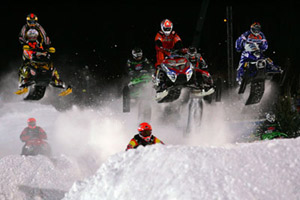Focus on America
Playing Into the Future

Participating in sports and physical activity has been an important part of the American lifestyle for more than a century. During that period, sports equipment and the games themselves have evolved and improved immeasurably. But Americans aren't resting on their laurels. They continue to find ways to make equipment and games better, safer, more environmentally friendly, and more engaging to their devotees.
X Marks the Spot
The X Games -- X for extreme sports — continue to push the boundaries of traditional sporting competitions each year by introducing new and exciting events while working to minimize the impact of the games on the environment. In January 2008, the Winter X Games 12 brings fans into the action, as scoring in certain events will come from live fan text voting.
X Games is the largest skateboarding competition in the world, but the games have grown tremendously to include BMX (short for bicycle Motocross, a sport that includes special bicycles that have larger or smaller wheels than traditional bicycles on which riders do tricks), water sports, snowboarding, rally car racing, bungee jumping, sky surfing, ice climbing, and many other "extreme" sports competitions and disciplines. Attendance has increased every year, and the X Games are now covered around the clock via television networks ESPN, ABC, and ESPNs online and wireless entities.
The Winter X Games 12 in Colorado will introduce Snowmobile Speed and Style, which combines the air of freestyle and the speed of SnoCross into one discipline. Competitors will go head to head around the course hitting multiple jumps and obstacles. Final scores will be based on difficulty of tricks pulled and amount of time racers take to ride around the full track.
Big Air contests — in which athletes compete to fly the highest in their discipline — have also been added to the existing skiing and snowboard competitions. Featuring only four competitors in each contest, the scoring of every run will be fan interactive: Fifty percent of each competitors score will come from live fan text voting, and 50 percent from the analysts calling the competitions live on TV.
Originally known as the Extreme Games, the X Games quickly expanded into a global event and marketing phenomenon larger than any of its creators likely imagined.
The Extreme Games were born in 1993 when executives at the ESPN television network decided to convene international athletes for a variety of summer action sports every other year. The inaugural Extreme Games were held in New England in 1995, featuring 27 events in nine sports categories.
The response from spectators, sponsors, and athletes was so favorable that ESPN opted to make the games an annual event. The event was renamed the X Games in 1996 and became a biannual occurrence to include winter sports in 1997. The first Winter X Games were telecast to nearly 200 countries and territories in 21 different languages, and they were also telecast on ESPNs parent network, ABC.
The X Games went green in 2004, introducing X Games Environmentality (XGE), a comprehensive program that drives environmental stewardship through all facets of event planning. XGE seeks to minimize the impact of the games on the environment through waste minimization, use of renewable resources, purchase of environmentally conscious products, and pollution prevention.
Less than two decades after their inception, the X Games are a worldwide hit among athletes, sponsors, and spectators, as well as a major branch of the ESPN brand.
Aesthetic Sports
Ingenuity in sports extends beyond technology and equipment to the games themselves. According to Annie Lok writing for the Columbia News Service, a handful of new hybrid, or "aesthetic," sports are beginning to make inroads into the sporting landscape.
Rutgers University graduate student Tom Russotti developed "Wiffle Hurling" as a softer variation on hurling, Irelands fast-paced and violent national sport. Using soccer goals, hollow plastic bats, and white plastic balls with holes in them — the equipment used to play Wiffleball — Russotti invented Wiffle Hurling when he was told that the original game was too violent for the uninitiated. Russotti heats the bats over a flame to flatten them, approximating the shape of the original hurling equipment. His adjustment to hurlings original equipment enables Whiffle Hurling to retain the intensity of hurling while making the game safer for new players.
Texan Eric Heiberg invented Mojo Kickball as an outlet for exercise. The game only vaguely resembles kickball, a combination of baseball and soccer played in many U.S. school gym classes, and also contains elements of dodgeball, another staple of gym classes. Mojo Kickball employs six balls, pitchers throw balls at their own team, and players score on third base.
Street bicycle polo has made a footprint in several American cities recently, and it differs from the other aesthetics in that a greater degree of physical dexterity is required. In this sport, players must be able to maintain their balance on their bikes while opponents come at them wielding polo mallets and vying for a field hockey ball.
One of the key advantages of aesthetic sports is that participants with varying degrees of athletic ability can play and play together. Heiberg was not a fan of ultracompetitive sports, and both he and Russotti wanted sporting avenues that provided more in the way of casual fun than competitiveness. All these endeavors provide people with an outlet for physical activity beyond the well-established sports to which weve grown accustomed.
Head Tech
Within the last 20 years, the term "concussion" has crept its way into the sports vernacular at all levels. Retired players in contact sports such as football and hockey speak of playing through "headaches" during their playing days, not realizing the severity of what might have actually been undiagnosed concussions.
Advancements in protective gear could help alleviate such concerns for the athletes of today. Riddell Sports Group, an Illinois-based manufacturer of sports equipment, has designed a line of football helmets rigged with sensors that can measure the severity of impacts and help detect possible concussions.
Equipped with Head Impact Telemetry System (HITS) technology, each helmet has six accelerometers in its lining. Developed by Simbex, LLC, a New Hamphsire-based company, these sensors measure the location, magnitude, duration, and direction of the impact. The data are transmitted continuously and wirelessly to a waterproof sideline computer monitored by team medical staff. Staff can monitor the data on an ongoing basis, but a pager alert is sent whenever one of the helmets registers a collision whose severity exceeds a certain predetermined limit.
At that point, the profile of the affected player can be called up on the computer screen, and team staff can see instantly the impact history of that player from previous practices and games.
Prior to the start of the season, each player is given a 25-minute computer-based test that determines his baseline brain behavior. If the sensory system alerts the medical staff to a possible head injury, the staff will give the test again and compare the results to the players baseline.
Repeat concussions are one of the heretofore hidden dangers of contact sports at all levels. Each successive concussion takes more of a toll on players, and the HITS technology will help ensure that players have proper recovery time after sustaining impacts that may produce concussions.
Gear Goes Green
Nearly 40 years after Earth Day was first celebrated in 1970, consumers have more environmentally sound choices available to them in almost every area of the marketplace. One of the more recent additions to the greening of consumer products is the sporting goods and fitness segment.
Because many surfboards have been coated with polyester resins that are harmful to the environment and the workers who handle them, some manufacturers have recently developed epoxy resins and natural composites. Not only are they more environmentally friendly, they resist bumps and scrapes better than the polyester-coated versions.
Footballs, soccer balls, and other high-end sports balls are traditionally made with a rubber inner air bladder and covered with polyurethane or synthetic leather. But continued and repeated harvesting of rubber can diminish forests. Seattle-based Fair Trade Sports manufactures balls that have inner bladders and outer coatings that meet Forest Steward Council (FSC) standards. The FSC certification ensures that the rubber comes from a responsibly managed forest, as mandated by international rules.
Millions of kids are skateboarders, and most serious boarders break at least one board a year. Instead of using wood, skateboard makers such as Comet, Habitat, Loaded Boards, and Sector 9 have started producing green boards made from bamboo or hemp fiberglass. Many boarders find the new eco-friendly models to be better performing, stronger, and more flexible.
Calfee Design is also using hemp and bamboo to make eco-friendly bicycles. The company has made high-end racing bikes from carbon fiber for the last two decades, but began to make the bamboo bikes about a decade ago. The bamboo models weigh slightly more than the carbon-fiber vehicles, but they can be better at absorbing road impact and vibrations. Colorado-based Venture Snowboards uses sustainable harvested wood, bamboo, organic cotton, and hemp to make its boards.
As long as performance and durability aren sacrificed, consumers seem willing to embrace equipment that is derived from ecologically friendly materials.
Recently on Focus on America
"Trailblazers" Honored by Rock and Roll Hall of Fame
 The artists honored by the Rock and Roll Hall of Fame in 2008 represent many of the styles and genres that have shaped the vibrant American musical landscape.
The artists honored by the Rock and Roll Hall of Fame in 2008 represent many of the styles and genres that have shaped the vibrant American musical landscape.
Spectacular Night Launch Sends Japan, Canada Devices to Station
 Two launches within three days are sending equipment and astronauts to the International Space Station (ISS), which will represent for the first time the interests of all five space station partners -- the United States, Japan, Canada, Russia and the European Space Agency (ESA).
Two launches within three days are sending equipment and astronauts to the International Space Station (ISS), which will represent for the first time the interests of all five space station partners -- the United States, Japan, Canada, Russia and the European Space Agency (ESA).
Shuttle Launches To Deliver European Space Agency Lab to Station
 With the February 7 afternoon launch of Atlantis through cloud-swept skies above Kennedy Space Center in Florida, the European Space Agency’s (ESA) most important contribution to the International Space Station -- its Columbus laboratory – is finally on its way to the orbital outpost.
With the February 7 afternoon launch of Atlantis through cloud-swept skies above Kennedy Space Center in Florida, the European Space Agency’s (ESA) most important contribution to the International Space Station -- its Columbus laboratory – is finally on its way to the orbital outpost.